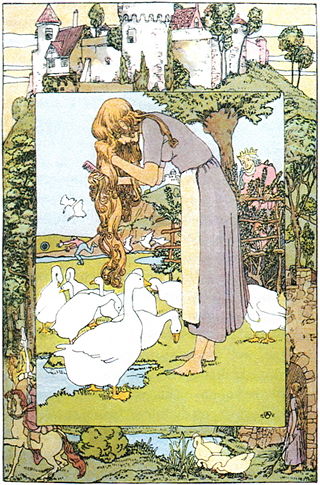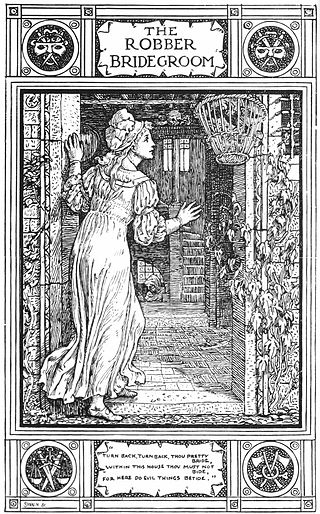
Sir Thomas de Ercildoun, better remembered as Thomas the Rhymer, also known as Thomas Learmont or True Thomas, was a Scottish laird and reputed prophet from Earlston in the Borders. Thomas' gift of prophecy is linked to his poetic ability.

"Bluebeard" is a French folktale, the most famous surviving version of which was written by Charles Perrault and first published by Barbin in Paris in 1697 in Histoires ou contes du temps passé. The tale tells the story of a wealthy man in the habit of murdering his wives and the attempts of the present one to avoid the fate of her predecessors. "The White Dove", "The Robber Bridegroom", and "Fitcher's Bird" are tales similar to "Bluebeard". The notoriety of the tale is such that Merriam-Webster gives the word Bluebeard the definition of "a man who marries and kills one wife after another". The verb bluebearding has even appeared as a way to describe the crime of either killing a series of women, or seducing and abandoning a series of women.

The Nixie, Nixy, Nix, Näcken, Nicor, Nøkk, or Nøkken are humanoid, and often shapeshifting water spirits in Germanic mythology and folklore.

Princess and dragon is an archetypical premise common to many legends, fairy tales, and chivalric romances. Northrop Frye identified it as a central form of the quest romance.

Heer Ranjha is one of the four popular tragic romances of the Punjab. The other three are Mirza Sahiban, Sohni Mahiwal and Sassi Punnun. There are several poetic narrations of the story; the most famous being Heer by Waris Shah written in 1766. It tells the story of the love between Heer Sial and Dheedo Ranjha.
"The Elfin Knight" is a traditional Scottish folk ballad of which there are many versions, all dealing with supernatural occurrences, and the commission to perform impossible tasks. The ballad has been collected in different parts of England, Scotland, Ireland, the US, and Canada. As is the case with most traditional folk songs, there have been countless completely different versions recorded of the same ballad. The first broadside version was printed before 1674, and the roots of the song may be considerably older.
Baš Čelik, meaning "head of steel", from Turkish baş for "head" and çelik for "steel", is a Serbian fairy tale, collected by Vuk Karadžić. It is similar to the Brothers Grimm's "The Crystal Orb".

"The Goose Girl" is a German fairy tale collected by the Brothers Grimm and first published in Grimm's Fairy Tales in 1815. It is of Aarne-Thompson type 533.
Catskin is an English fairy tale collected by Joseph Jacobs in More English Fairy Tales. Marian Roalfe Cox, in her study of Cinderella, identified as one of the basic types, the Unnatural Father, contrasting with Cinderella itself and Cap O' Rushes.
"Lady Isabel and the Elf Knight" is the English common name representative of a very large class of European ballads.

"The Robber Bridegroom" is a German fairy tale collected by the Brothers Grimm, tale number 40. Joseph Jacobs included a variant, Mr Fox, in English Fairy Tales, but the original provenance is much older; Shakespeare alludes to the Mr. Fox variant in Much Ado About Nothing, Act 1, Scene 1:

The youngest son is a stock character in fairy tales, where he features as the hero. He is usually the third son, but sometimes there are more brothers, and sometimes he has only one; usually, they have no sisters.

"The Twa Sisters" is a traditional murder ballad, dating at least as far back as the mid 17th century. The song recounts the tale of a girl drowned by her jealous sister. At least 21 English variants exist under several names, including "Minnorie" or "Binnorie", "The Cruel Sister", "The Wind and Rain", "Dreadful Wind and Rain", "Two Sisters", "The Bonny Swans" and the "Bonnie Bows of London". The ballad was collected by renowned folklorist Francis J. Child as Child Ballad 10 and is also listed in the Roud Folk Song Index ., Whilst the song is thought to originate somewhere around England or Scotland, extremely similar songs have been found throughout Europe, particularly in Scandinavia.
"Young Beichan", also known as "Lord Bateman", "Lord Bakeman", "Lord Baker", "Young Bicham" and "Young Bekie", is a traditional folk ballad categorised as Child ballad 53 and Roud 40. The earliest versions date from the late 18th century, but it is probably older, with clear parallels in ballads and folktales across Europe. The song was popular as a broadside ballad in the nineteenth century, and survived well into the twentieth century in the oral tradition in rural areas of most English speaking parts of the world, particularly in England, Scotland and Appalachia.

The Laidly Worm of Spindleston Heugh, also known as The Laidly Worm of Bamborough, is a Northumbrian ballad about a princess who is changed into a dragon.

"Kemp Owyne" is Child Ballad number 34.
"Gil Brenton" is Child ballad 5, Roud 22, existing in several variants.

Folklore of the Low Countries, often just referred to as Dutch folklore, includes the epics, legends, fairy tales and oral traditions of the people of Belgium, Netherlands and Luxembourg. Traditionally this folklore is written or spoken in Dutch or in one of the regional languages of these countries.
French folklore encompasses the fables, folklore, fairy tales and legends of the French people.

The Necklace of Harmonia, also called the Necklace of Eriphyle, was a fabled object in Greek mythology that, according to legend, brought great misfortune to all of its wearers or owners, who were primarily queens and princesses of the ill-fated House of Thebes.













